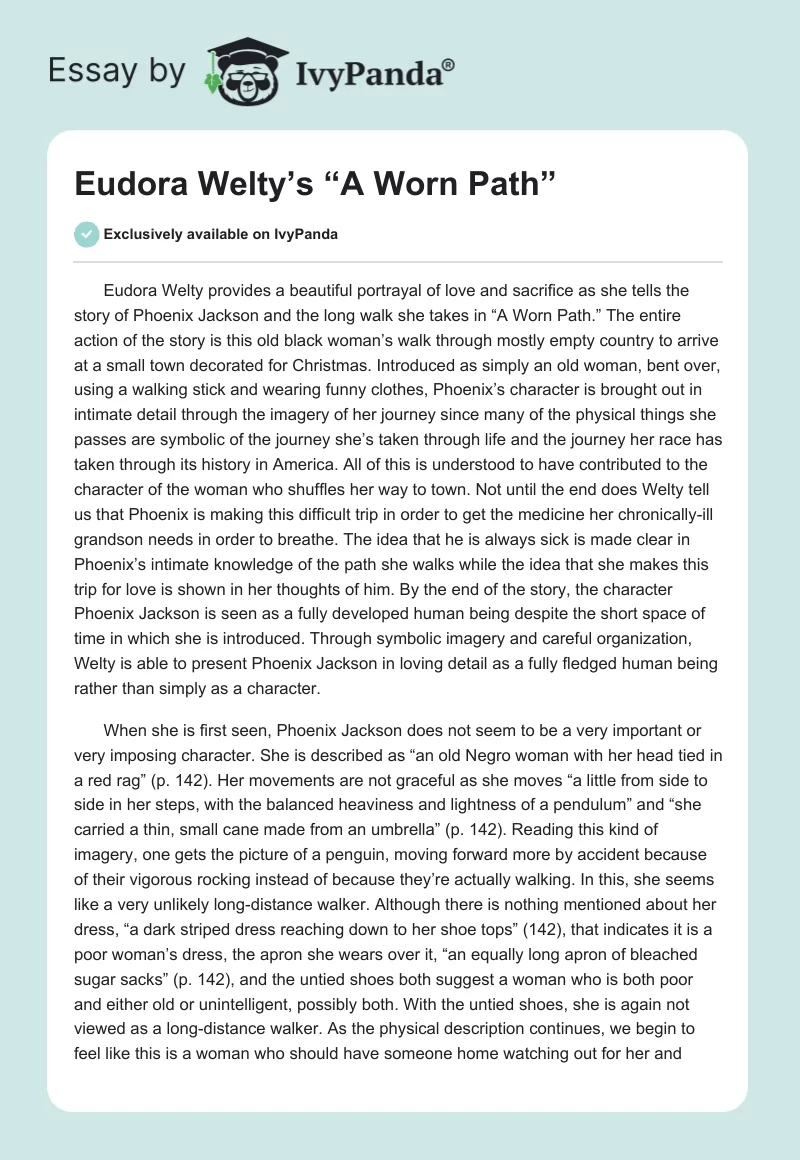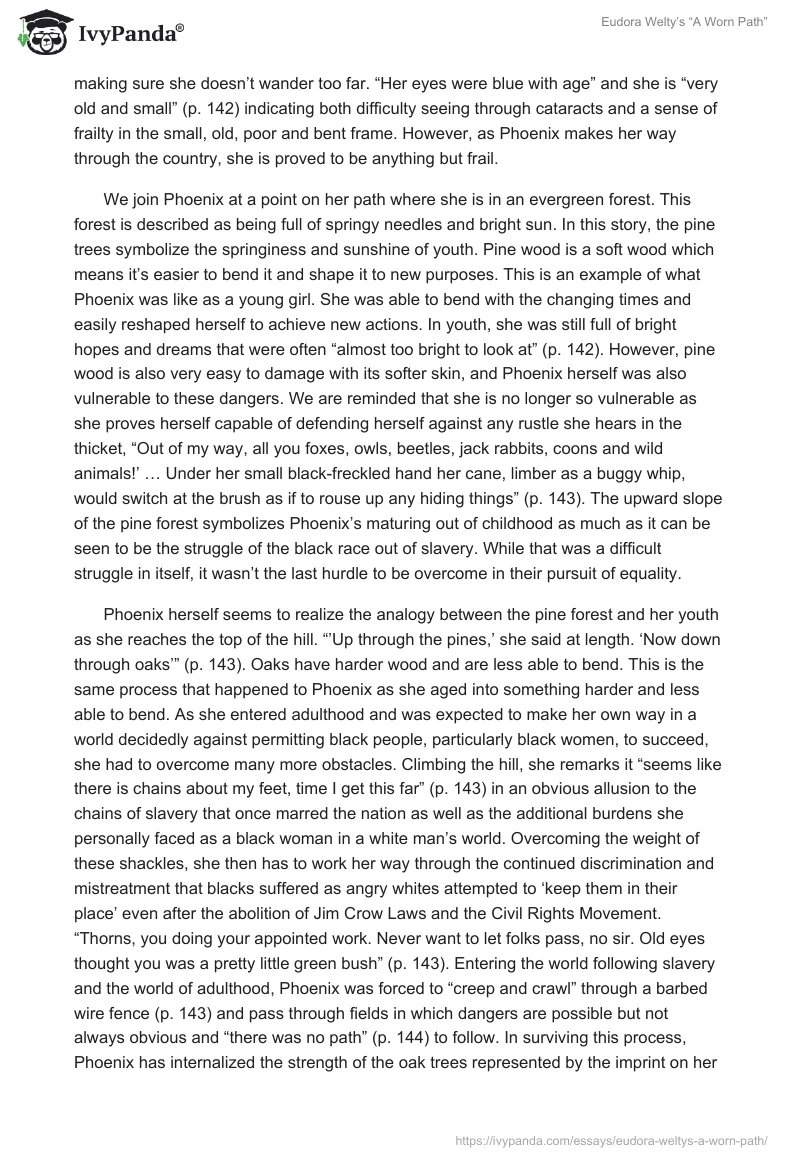Eudora Welty provides a beautiful portrayal of love and sacrifice as she tells the story of Phoenix Jackson and the long walk she takes in “A Worn Path.” The entire action of the story is this old black woman’s walk through mostly empty country to arrive at a small town decorated for Christmas.
Introduced as simply an old woman, bent over, using a walking stick and wearing funny clothes, Phoenix’s character is brought out in intimate detail through the imagery of her journey since many of the physical things she passes are symbolic of the journey she’s taken through life and the journey her race has taken through its history in America. All of this is understood to have contributed to the character of the woman who shuffles her way to town.
Not until the end does Welty tell us that Phoenix is making this difficult trip in order to get the medicine her chronically-ill grandson needs in order to breathe. The idea that he is always sick is made clear in Phoenix’s intimate knowledge of the path she walks while the idea that she makes this trip for love is shown in her thoughts of him. By the end of the story, the character Phoenix Jackson is seen as a fully developed human being despite the short space of time in which she is introduced. Through symbolic imagery and careful organization, Welty is able to present Phoenix Jackson in loving detail as a fully fledged human being rather than simply as a character.
When she is first seen, Phoenix Jackson does not seem to be a very important or very imposing character. She is described as “an old Negro woman with her head tied in a red rag” (p. 142). Her movements are not graceful as she moves “a little from side to side in her steps, with the balanced heaviness and lightness of a pendulum” and “she carried a thin, small cane made from an umbrella” (p. 142). Reading this kind of imagery, one gets the picture of a penguin, moving forward more by accident because of their vigorous rocking instead of because they’re actually walking. In this, she seems like a very unlikely long-distance walker.
Although there is nothing mentioned about her dress, “a dark striped dress reaching down to her shoe tops” (142), that indicates it is a poor woman’s dress, the apron she wears over it, “an equally long apron of bleached sugar sacks” (p. 142), and the untied shoes both suggest a woman who is both poor and either old or unintelligent, possibly both. With the untied shoes, she is again not viewed as a long-distance walker.
As the physical description continues, we begin to feel like this is a woman who should have someone home watching out for her and making sure she doesn’t wander too far. “Her eyes were blue with age” and she is “very old and small” (p. 142) indicating both difficulty seeing through cataracts and a sense of frailty in the small, old, poor and bent frame. However, as Phoenix makes her way through the country, she is proved to be anything but frail.
We join Phoenix at a point on her path where she is in an evergreen forest. This forest is described as being full of springy needles and bright sun. In this story, the pine trees symbolize the springiness and sunshine of youth. Pine wood is a soft wood which means it’s easier to bend it and shape it to new purposes. This is an example of what Phoenix was like as a young girl. She was able to bend with the changing times and easily reshaped herself to achieve new actions. In youth, she was still full of bright hopes and dreams that were often “almost too bright to look at” (p. 142).
However, pine wood is also very easy to damage with its softer skin, and Phoenix herself was also vulnerable to these dangers. We are reminded that she is no longer so vulnerable as she proves herself capable of defending herself against any rustle she hears in the thicket, “Out of my way, all you foxes, owls, beetles, jack rabbits, coons and wild animals!’ … Under her small black-freckled hand her cane, limber as a buggy whip, would switch at the brush as if to rouse up any hiding things” (p. 143). The upward slope of the pine forest symbolizes Phoenix’s maturing out of childhood as much as it can be seen to be the struggle of the black race out of slavery. While that was a difficult struggle in itself, it wasn’t the last hurdle to be overcome in their pursuit of equality.
Phoenix herself seems to realize the analogy between the pine forest and her youth as she reaches the top of the hill. “’Up through the pines,’ she said at length. ‘Now down through oaks’” (p. 143). Oaks have harder wood and are less able to bend. This is the same process that happened to Phoenix as she aged into something harder and less able to bend. As she entered adulthood and was expected to make her own way in a world decidedly against permitting black people, particularly black women, to succeed, she had to overcome many more obstacles.
Climbing the hill, she remarks it “seems like there is chains about my feet, time I get this far” (p. 143) in an obvious allusion to the chains of slavery that once marred the nation as well as the additional burdens she personally faced as a black woman in a white man’s world. Overcoming the weight of these shackles, she then has to work her way through the continued discrimination and mistreatment that blacks suffered as angry whites attempted to ‘keep them in their place’ even after the abolition of Jim Crow Laws and the Civil Rights Movement.
“Thorns, you doing your appointed work. Never want to let folks pass, no sir. Old eyes thought you was a pretty little green bush” (p. 143). Entering the world following slavery and the world of adulthood, Phoenix was forced to “creep and crawl” through a barbed wire fence (p. 143) and pass through fields in which dangers are possible but not always obvious and “there was no path” (p. 144) to follow.
In surviving this process, Phoenix has internalized the strength of the oak trees represented by the imprint on her forehead. “Her skin had a pattern all its own of numberless branching wrinkles and as though a whole little tree stood in the middle of her forehead, but a golden color ran underneath” (p. 142). The golden color underneath reminds the reader again of the yellow color of the pine and the girl who Phoenix once was.
At the same time, it reminds us of the resiliency of the human being and the concept that the black race may bend to work within the established parameters, but they will not break as they continue to make their way toward actual equality with whites. Through her struggles, Phoenix has managed to reach the other side of the log bridge, the other side of adulthood, where the trees have been put to more difficult tests by the wind and weather representing Phoenix’s greater maturity and strength.
Although she is still strong internally, she has become stronger because she now knows her weaknesses and limits, having tested all of her boundaries. It is at this point that she feels she is deserving of a short rest, choosing to sit down under “a pearly cloud of mistletoe” (p. 143). She accepts herself as she is and is at peace with it, yet “She did not dare close her eyes” (p. 143) because of her concern that she might drift off to a more permanent rest. It is the little boy who “brought her a plate with a slice of marble-cake on it” (p. 143) in her mind who reminds her of the purpose for her trip and gets her moving again.
While she has managed to get to a point in life she can be satisfied with, she is not immune to new surprises, discovered in the form of a “black dog with the lolling tongue” (p. 145) that sends Phoenix heels over head into the ditch “like a little puff of milkweed” (p. 145) accompanied by a white owner who “laughed and lifted his gun and pointed it at Phoenix” (p. 146).
However, her experience has made her capable of taking advantage of the situation now, cleverly distracting the man so that she can pocket the nickel he dropped and use it to purchase a toy for her grandson. The reasons Phoenix fights her way through the country is the same reason anyone fights for any improvement in standards, for the love of a future generation.
Through Welty’s use of imagery, this frail old woman, with her half-verbal mumblings and shaky forward progress, becomes more than a real person to us as we begin to sympathize with the challenges she’s overcome in her journey. On a deep level, it is understood that this journey is not simply intended to represent the journey of a physical walk, but also the journey this woman has taken throughout her life and that her race is still taking now. Yet it is also shown how these tests of strength and conviction are what have brought out the beauty of the woman, the conviction of her love and her courage and determination to accomplish her goals.
Works Cited
Welty, Eudora. The Collected Stories of Eudora Welty. New York: Harcourt Brace, pp. 142 – 149.


